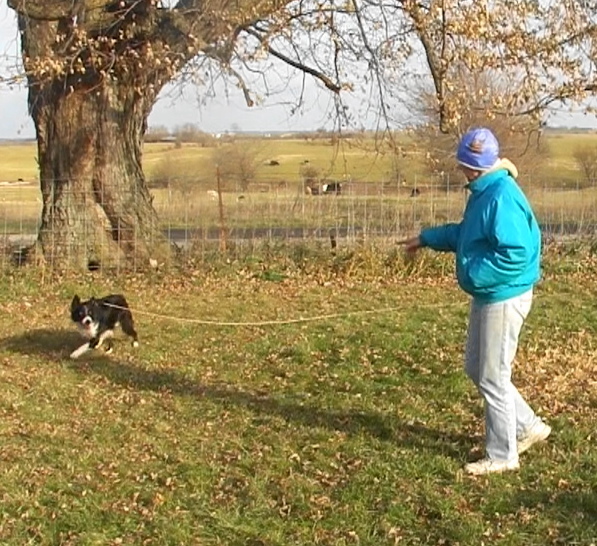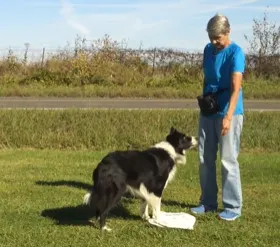PHD Blog 6 - Fake it
Fake it 'till you make it
Harried Handler: My dog is very uncomfortable with the pressure from the sheep and her response is to dive in. It feels like she is very anxious and constantly trying to overcompensate.
Communication with our dogs is limited, so how do we get our dogs to understand that we want them to be more relaxed as they work stock? (I trust that having a relaxed, thinking dog is preferred by most handlers to a reacting robot dog.) We may not know what our dogs are thinking but we can see how they are reacting and the tension they have in their body and movements.
First, we need to understand why our dogs are tense and reactive to stock. The primary culprits are:
- Instinct – Tells our dogs to react in a certain way but not necessarily always the best way.
- Arousal – Level of stress caused by an environmental situation, read livestock.
- Tension – Often is transferred from the overwhelmed handler and the nervous stock to our dog.
- Inexperience – It’s difficult to be confident in a new, fast-moving situation.
- Ignorance - Although a dog may have innate herding instincts, that doesn’t mean that they always know how to control and move livestock.
Since we cannot verbally tell our dogs to relax, we need to show and teach them how to interact appropriately with stock. Let’s start with what the handler can do to help their dog relax.
The handler can:
- Slow down their breathing.
- Give cues quietly.
- Keep training sessions short.
- Move slowly.
- Pause the training frequently and take short breaks.
- Throw handfuls of treats in the grass for the dog to snarf up.
- Switch from tugs and toys to using treats as reinforcers, if play winds up the dog.
- Break training down into smaller steps so the dog has a higher rate of success and reinforcement.
- Keep the dog on a leash or long line so the handler is confident the dog will not get out of control and cause a train wreck.
I use all of these practices, but they can only help a dog so much. What really helps is to teach our dog how to behave and react to livestock. If we don’t want our dog to “dive in” to the sheep, what do we want them to do?
Why do they dive in? Before we get to training a new response, let’s look at why our dog is giving us their current response. The dog wants to control the sheep (instinct) but is insecure about how to do that (training). They get in front of the flock to stop movement but then they find themselves facing several sheep without knowing how to react to the situation they have created. This makes them uncomfortable. Instinct puts them into a situation but lack of training (or instinct) may leave them ill-equipped to handle the situation. Outcome = dive in!
Which type of situation bothers a dog varies from dog to dog. If your dog likes to move stock (forward-moving dog), they may feel tension when asked to stop or flank around the stock. If your dog likes to control stock (sideways-moving dog), they may feel tension when asked to apply pressure and walk into stock. Of course, your dog’s general level of confidence around livestock will dictate how much stress each situation causes them.
What can we do about it? Have you ever heard the suggestion, if you feel nervous try changing your posture to a more confident pose? In other words, fake it ‘till you make it. That is exactly how I handle this situation with my dogs.
I train a behavior, such as a trotting flank instead of a running flank, and this well-trained behavior, when cued, will override the dog’s instinctual response. If the dog finds this alternate behavior works for them they will often adopt the new behavior, apply it in new situations (generalization), and become more confident.
Here is how I handled a problematic situation with Sir:
From Positive Herding 101:
Generalizing easy from flank to fetch
Another example of teaching a dog to implement a known behavior in a new situation, generalization, is one I faced with Sir Gold. Sir is very athletic and quick. He likes to flank fast and this often leads to reacting instead of thinking. I needed to teach Sir to flank easy, the slow down behavior explained in Chapter 22, to get him to relax and slow down when flanking. When I taught Sir to slow down while flanking I did not realize he would generalize this behavior to his outrun and thus vastly improve his lift.
The fetch situation with Sir was that he would do a nice outrun but come in too fast on top behind the sheep startle them instead of starting or lifting them calmly towards me. When he did occasionally come in and lift the sheep calmly the fetch that followed was picture-perfect but, when he flushed the sheep the fetch was too fast with quick, frantic flanks as Sir overreacted to the sheep’s erratic movements.
Sir had no problem generalizing the speed change when I moved from my front yard to sheep. I worked in a small paddock with penned sheep to transition slowing down while flanking. I did put a long line on Sir so that I could give a small tug to lightly punish his maintaining the current gait when cued to drop down one gait. Since Sir liked to flank quickly continuing to flank at speed was self-reinforcing for him. Waiting for him to tire and slow down voluntarily was my preferred option but I did not want him mindlessly orbiting the sheep. Because of the previous training of hurry and easy with a target stick away from livestock Sir was soon slowing down and speeding up around sheep on cue.

When transitioning the easy cue to livestock (present in the paddock but not in this picture) I had Sir on a light long line and used my extended arm to prompt him to slow down when cued. At the beginning of this session when Sir was highly distracted by the sheep’s movement I needed to give a light tug on the line when he did not drop down one gait when cued but after 2 or 3 tugs he started taking my easy cue so I dropped the line and let him drag it. Later in the session, I also faded my arm prompt.
Once Sir had generalized speed up and slow down around loose sheep in a small paddock I decided to try a very short fetch in that paddock. The length of the outrun was constrained by the size of the little paddock. Before teaching Sir to slow down his fetch in the small paddock was virtually nonexistent. He would flank around the sheep so quickly that they would flush off of the far fence long before he could get behind them and they would be at my feet before he had any chance to fetch them.
I gave Sir his fetch cue as usual and expected him to blast around behind the sheep with the usual explosive result. I purposely did not ask him to slow down on his little outrun to see how he would handle it. I expected a rocketing outrun since we had not worked on generalizing the slow down while flanking to slow down while fetching. When flanking I was in the center of the paddock near the sheep but when fetching I sent Sir from my feet.
As soon as I sent Sir everything was different! He trotted on his outrun, which was the appropriate pace given the space constraints, calmly lifted the sheep, and fetched them the short distance to me. I was amazed! Sir had generalized slowing down to a new behavior without any help from me. The behavior generalized because it helped Sir control and handle the sheep and thus was self-reinforcing for him. I believe Sir just did not realize that he could slow down while fetching, it was not in his innate repertoire. Once it was introduced he immediately adopted it because it worked for him.
Sometimes we assume that our dogs behave in a certain way because they find it self-reinforcing, and they may, but they also may behave in that way because they don’t know any other way to behave in that situation.
I teach my dog new behaviors (tools) to deal with situations they find uncomfortable. If a dog is just reacting they often don’t know any other way to act. Sometimes a dog doesn’t even realize they can react differently.
Come bye to learn more about herding!
Join my list to receive the latest news and updates.
(Don't worry, your information will not be shared.)

